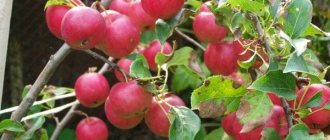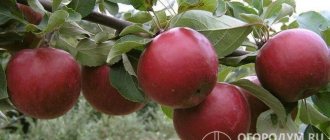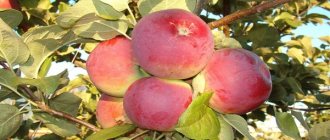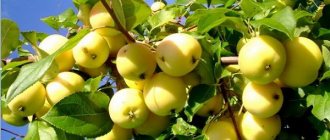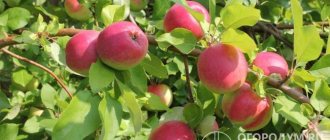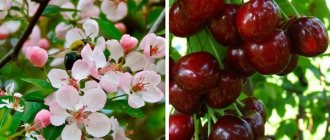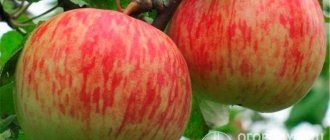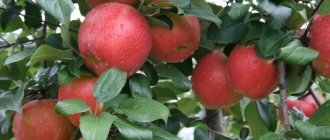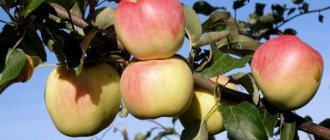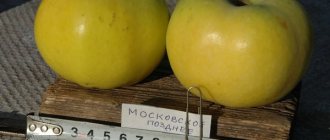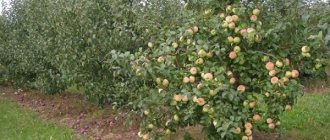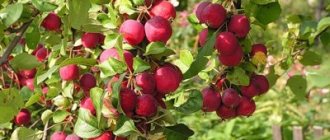The Chinese Golden apple tree is an early summer variety of Russian selection, bred at the beginning of the 20th century. Its small liquid fruits of a creamy yellow hue are called “paradise apples” for their pronounced pleasant aroma and sweet taste with a subtle sourness. This tree is the highlight of any garden or summer cottage: in the spring its branches are covered with fragrant large white flowers, and already at the end of July they are buried in clusters of plump golden fruits, which ensures the plant’s decorative appearance throughout the entire season.
"Golden China" (pictured) - brings significant harvests of small amber-yellow fruits
We invite you to read a detailed description of the Chinese Golden apple tree, consider its advantages and disadvantages, and also find out the opinions of experienced gardeners about this variety. Let's start with the main characteristics shown in the table:
| Parameter | Characteristic |
| Culture | Apple tree (Malus domestica Borch.) |
| Variety | "Chinese golden early" |
| Height | The tree is medium-sized, 5 to 7 m high |
| Precociousness | High – 3-4 years after planting |
| Terms of removable (technical) maturity | Late July – early August |
| Period of consumption/shelf life of fruits | Summer – fruits cannot be stored for long periods of time |
| Type of fruiting | Fruiting is concentrated mainly in the upper third of the branches |
| Productivity of an adult tree | Low (up to 30 kg per tree). Fruits regularly |
| Size and weight of fruits | On average 25-30 g, maximum - 40 g, the size of the apple rarely exceeds 5-6 cm in diameter |
| Shape and color | The fruit has a regular round shape with mild ribbing. The stalks are short. At the beginning of ripening, the skin is light yellow with a greenish tint, with numerous small subcutaneous light dots. Covered with a waxy coating of medium intensity. When ripe, it acquires a rich amber-yellow color, sometimes with a reddish blurred blush. |
| Fruit pulp | Juicy, dense, yellowish in color, with a pronounced apple aroma |
| Tasting assessment (taste qualities) | 4.4-4.6 points (out of 5) – the taste is very pleasant, sweet and sour |
| Purpose of fruits | Dessert (universal). Apples are eaten fresh and also used to make wine, jams, and candied fruits. |
| Sustainability | High to drought and frost; weak to scab |
| Lifespan | About 70 years old |
| Year of inclusion in the State Register of the Russian Federation | 1947 |
| Recommended growing regions | North-Western, Volgo-Vyatsky |
| Originator | Federal State Budgetary Institution "Federal Scientific Center named after I.V. Michurin" (Tambov region) |
Origin and zoning
A variety with unique characteristics was bred by the famous domestic breeder I.V. Michurin in 1907 in his nursery, which was located at that time in the city of Kozlov (now Michurinsk) in the Tambov region. When creating, the method of interspecific hybridization was used: crossing by pollinating “White filling” with pollen of the semi-cultivated “China” (plum-leaved) - very hardy and resistant to low temperatures and droughts.
In the photo there are apple trees “White filling” (left) and “Chinese” (right), which served as the initial forms
“Chinese golden early” combines the best qualities of both “parents”, primarily early ripening of fruits, high vitality and ecological plasticity, that is, adaptability to various weather and climatic conditions.
In 1947, the variety was officially included in the State Register of the Russian Federation. Since then, it has gained popularity among gardeners and summer residents, who highly appreciated its decorative appearance and balanced taste of apples - sweet with a slight sourness. This cultivated variety of "Chinese" bears fruit best in regions with a temperate continental climate, which is characterized by not too severe winters and cloudy weather most of the year. The variety is zoned in the North-Western and Volga-Vyatka regions, but also takes root well in colder conditions.
Apple picking and storage
Fruits are stored quite well in the refrigerator, but only if there is no mechanical damage. Some varieties are able to retain their qualities until the beginning of winter. If you have a basement, apples can be laid out in a wooden box and stored at 0 °C.
If the fruits are dried outside or in a special machine, they can be turned into dried fruits. Processing into jam, marmalade, etc. is also carried out.
General description of the tree
The apple tree is medium-sized, its height reaches a maximum of 6-7 meters. The crown of young trees is broom-shaped, with a rather sparse leaf canopy concentrated on its periphery. The branches are thin, covered with yellow-brown bark with a greenish tint. In relation to the trunk they are located at an acute angle.
The fruits are collected in small clusters (3-5 pieces each), concentrated mainly on the upper third of the branches
The branches on an adult tree are spreading and weeping, since the fruits are located mainly at their ends and ripen in clusters of 3-5 pieces. Young shoots are straight, light, greenish-yellow. The leaves on thin and long petioles are oblong, light green, jagged at the edges (crenenate), slightly pubescent. When the fruits ripen, they seem invisible, and the branches appear bare.
Growing an apple tree
Subsequent care for Chinese seedlings consists of:
- glaze;
- feeding;
- trimmings;
- prevention and control of diseases and pests;
- preparation for winter.
It is interesting to read about the cultivation of such summer apple varieties as Medunitsa and Mantet.
Fertilization and watering
Chinese varieties are afraid of stagnation of water in the roots and are tolerant of drought. These trees should not be watered frequently, limiting yourself to 4 buckets of settled warm water once every 10 days. Each watering, as well as the previous rain, must be accompanied by loosening the tree trunk circle to ensure good access of oxygen to the root system. Before the onset of frost, the tree trunks of apple trees are mulched with a thick layer of humus.
The frequency of loosening can be reduced by mulching the soil, using:
- dry sawdust;
- crushed peat;
- hay;
- dry humus;
- crushed bark.
When the seedlings, 2 years after planting, have used up the fertilizers applied during planting, in the spring they should be fed 3 weeks before flowering with nitrogen-containing fertilizers, organic matter, and ammonium nitrate.
During the period of ovary formation, the tree is fed a second time with 250 g of nitrophoska, which is diluted in 10 liters of water. When the harvest has already been harvested, the apple trees are fed a third time with 150 g of potassium sulfate and 250 g of superphosphate for each bucket of water. This fertilizing helps the tree to better survive the winter.
Pruning and crown formation
The variety of varieties of the Kitayka variety is expressed in the height of the trunk, the density of the crown and the growth rate of the branches, which determines different pruning needs in each specific case.
Important! Pruning should be done only if the daytime ambient temperature does not fall below +8°C. And yet, there are general principles of this operation for the entire species range of the described variety: And yet, there are general principles of this operation for the entire species range of the described variety:
And yet, there are general principles of this operation for the entire species range of the described variety:
- The main purpose of pruning young trees is to form the crown, and for adults - to prevent excessive thickening.
- In the spring, before sap flow begins, trees must be freed from branches that have dried and damaged during wintering.
- After leaf fall in the fall, pruning is carried out to give the crown the required shape.
- Pruning that forms the crown should be done in the second year of the tree’s life, for which it is necessary to identify 6 main skeletal branches. After this, all crooked and improperly growing branches are removed, as well as shoots growing below the first main branch. The main task in this case is to eliminate branches that compete with the leading trunk in terms of strength and growth rate.
- Secondary branches should be evenly spaced around the trunk, forming a regular crown.
- When thinning the crown, you must carefully ensure that all the branches that give it its shape do not obscure each other’s light.
- When pruning, you must follow the rule that annual pruning is much preferable to one-time total pruning, which is fraught with loss of the entire crop.
- During the pruning process, you must use only sharply sharpened and disinfected tools, and coat the cutting points with garden varnish.
Pollinator varieties
Chinaka apple trees require third-party pollinators to obtain high yields.
Pollination is most effective through:
- Antonovka;
- White filling;
- Slavyanka;
- Grushovka Moscow;
- Cinnamon Striped;
- Autumn striped;
- Saffron.
Also learn about the features of growing and caring for the Champagne Splash apple tree.
Features of pollination and fruiting
"Golden China" is self-sterile, so it needs pollinators. Experienced gardeners recommend planting it near the “White Fill” or “Moskovskaya Grushovka” trees.
The variety is characterized by high early fruiting: with proper tree care and favorable weather conditions, the first fruits appear already in the second year after planting. Productivity gradually increases over the next couple of seasons.
Abundantly blooming paradise apple trees become a real decoration of the spring garden
After 4-5 years, one apple tree can produce up to 28-32 kg of fruit . This is a good indicator, given the small size of the tree and the intended use of the variety for the northern regions of our country. Quantitative indicators of harvests may differ in different years, since the apple tree is prone to periodic fruiting. But it can be stimulated by using complex fertilizers to enrich the soil composition.
Features of cultivation in the regions
The Golden Chinese apple tree can be found in all corners of Russia. For the survival and development of seedlings, the climatic conditions and soil composition characteristic of a given region should be taken into account.
In Siberia
For Siberia, Chinese Zolotaya has become a permanent resident due to its winter hardiness and flowering.
Worth considering! In the garden where Kitayka grows, the productivity of other apple trees increases.
A seedling is planted in the spring at 3 years of age :
- Dig a hole 80 cm deep and 1 m wide;
- Then sand, humus, and leaves are added and dug up;
- A seedling is placed on the prepared soil, the roots are straightened, buried and watered.
Further care consists of feeding and pruning the tree. In this region, the apple tree should be treated with the stimulant "Energen" or the drug "Bud" .
In outskirts of Moscow
Apple trees are planted in the Moscow region early spring , in early April. Before starting work, prepare the place . For this:
- Dig a trench 70 cm deep and fill it with gravel, crushed stone and sand for drainage;
- Then the area is covered with soil and the soil is waited for to shrink;
- After time, a hole 50 cm deep and about 70 cm wide is dug in this place and a tree is planted;
- Before planting, the rhizomes of the apple tree are treated with a mixture of mullein and clay;
- Immediately upon completion of the work, the crown is trimmed so that it matches the diameter of the roots.
In the Leningrad region
In the Leningrad region, the best time to plant a seedling is early October , when it does not require nutrients. Before planting, it is necessary to fertilize the soil of the dug hole. If the soil is sandy, add peat, dried clay and rotted manure. River sand and humus leaves are added to peat soil.
After adding the components, the soil is dug up and watered. The seedling is placed in a prepared hole and covered with soil, compacting it well. Further care consists of watering and pruning.
In the Urals
Apple trees are planted in the Urals in the spring after the snow melts . The landing site is prepared in the fall. To do this, dig a hole, dividing the upper and lower layers of earth on opposite sides, since the lower one is less fertile.
Then fill the hole with the top layer of soil, fertilizer, and the bottom layer of soil. In May, an apple tree is planted in this area and watered abundantly. To protect the apple tree from the strong winds characteristic of this region, it is recommended to tie the seedling to a support after planting.
Advice! To prevent the seedling's rhizomes from freezing, the circum-trunk circle is covered with humus and peat to a depth of 5-7 cm.
In the middle lane
In central Russia, golden Chinese plant is planted in the spring until April 20. For planting, organic fertilizers, compost, humus and sand are added to the dug hole. Then the seedling is placed vertically in the recess, buried and watered abundantly.
When planting, the root collar should not be deepened ; its location should be 5-6 cm above ground level. Caring for an apple tree involves loosening the soil, removing weeds, identifying pests and properly forming the crown.
The root collar should not be allowed to deepen.
In the northern regions
For better survival of apple trees in the northern regions, the soil at the planting site must be loose, with good air and moisture permeability . The seedling is planted in the fall in mid-September . In this region, the soil is quite heavy, which is why the size of the depression is increased to 90 cm with a diagonal of at least 1 m.
Inverted turf with grass is laid at the bottom of the pit and a mixture of ash and manure is added. Next, they place the seedling in a hole, water it and bury it. After autumn planting, the apple tree requires special attention. Tree care involves identifying pests, forming the crown and feeding with nitrogen fertilizers.
Qualities and purpose of fruits
The apples are quite small - only 5-6 cm in diameter, regular rounded in shape without pronounced ribbing. The average weight of one fruit is about 30 g (20-40 g). The skin is thin but durable, with numerous subcutaneous light spots. When ripe, it acquires a rich golden color, which is why this variety of apples got its name. There is no topcoat coloring.
Paradise apples are small, but very beautiful - regular shape and rich golden yellow color
The pulp is creamy-yellowish, crispy, juicy, aromatic. When ripe, the apple “pours” and, if you remove the waxy coating from the peel, you can see the seeds in the light.
The taste is sweet, with moderate sourness, balanced, delicate. According to tasting scores - 4.4-4.6 on a 5-point scale . Apples are eaten fresh and also processed. They contain pectins, ascorbic acid, sugars, vitamins, microelements and other active substances, so winter preparations are tasty and healthy.
The apple tree belongs to the early summer varieties; the technical maturity of the fruit occurs at the end of July (approximately after the 25th). The harvest is harvested until mid-August. Ripening is uneven - ripe fruits fall to the ground and quickly deteriorate.
The main part of the harvested crop is processed, preparing very tasty preserves, jam, candied fruits, marmalade, compote and wine for the winter.
The shelf life of apples is extremely low; they are stored no longer than 5-8 days. After this period, the pulp becomes “cotton”, the fruits lose their taste and attractive appearance. They are also not subject to transportation, during which they quickly become covered with brown spots and begin to deteriorate.
Description of the apple tree variety Kitayka golden
This old Michurin variety of apples is grown not only for harvesting, although its fruits are tasty and aromatic, but also for decorative purposes. It is highly resistant to low temperatures, which is why it is widespread in different regions of our country, and also bears fruit early. It is not customary to grow golden china on an industrial scale, since the keeping quality of apples leaves much to be desired.
Apples: color, size, weight
The fruits of this tree are quite small, no more than 30-50 grams even for the largest-fruited varieties. At first the apples have a greenish and light green hue, but as they ripen they turn golden yellow, hence their name. Their skin is thin and easily damaged. Therefore, these apples cannot be transported at all. When fully ripe, they “pour”, become translucent, and you can even see the seed pods inside when exposed to light. The chemical composition per 100 grams of product is characterized by the following substances:
- Ascorbic acid (vitamin C) – 17.7-17.9 milligrams.
- Total sugars (fructose) – 18.8%.
- P-active substances – 162 milligrams.
- Pectins (fiber) – 11-12%.
- Acidity – 2.91%.
- Polyphenols – 0.88%.
The fruits do not hold well on the branches and quickly fall off when overripe or shaken off (wind, rain). Their pulp is very tender, juicy, quite sweet, but with a pronounced characteristic sourness, white or transparent white. There is no official tasting rating for these apples.
Chinese golden apple tree: characteristics
Crown and root system
It is believed that the Chinese golden tree is a medium-sized tree, although under favorable conditions it can easily reach a height of 6-7 meters. However, gardeners usually use pruning to shape the crown so that it does not rise beyond 3-4 meters. At an early age, the crown has a pronounced broom-like shape, the branches extend from the main trunk at an acute angle. Over time, it becomes spreading, as if weeping, and can occupy an area of up to 4-6 meters in diameter.
The bark on young shoots is light green in color; over the years it becomes coarser, may become grayish or brown, and become covered with cracks and roughness. The leaves are large, elongated, pointed, with uneven edges, light green, and do not have a characteristic leathery tint. The root system is entirely dependent on the rootstock, but is mostly superficial and branched.
Productivity and pollination
Chinese golden is not a self-fertile variety, therefore, without the presence of nearby pollinators, no fruits will be obtained. Therefore, no more than 150-200 meters away it is necessary to plant varieties that are suitable for flowering periods. In addition, she herself can act as a pollinator.
The problem is the shedding of fruits during ripening, which are best collected at the earliest stages. As soon as they begin to stop melting even a little, they will immediately fall to the ground.
This drought- and frost-resistant tree begins to bear fruit 2-3 years after the seedling is planted in open ground. The tree reaches full fruiting only in 5-8 years. However, one cannot expect high yields, due to the fact that the apples are small. It is believed that the lifespan of a tree is very long; it can produce a harvest even in its seventieth year of life.
No more than 25-50 kilograms of fruit can be removed from one tree.
Winter hardiness and disease resistance
This Chinese woman's resistance to low temperatures is quite high, but it is difficult for her to withstand frosts of more than -40°C. Therefore, it is common in many regions, except the Far East and Siberia. In this case, the tree may not die completely, but suffer greatly.
You will have to carefully care for the tree, because it has no immunity to scab or other “apple” diseases.
Subspecies and rootstocks
Subspecies
| Subspecies | Description |
| Decorative | In this subspecies, formative pruning of the crown is not carried out, since it is not overly thickened anyway. It has ellipsoid leaves, pointed and elongated. It blooms with large, bright pink flowers that are very fragrant, and bears fruit with small yellow apples of a sour-sweet taste. |
| Early | An early ripening and very resistant to dry weather subspecies. It does not have high resistance to frost, like others, but is especially common in the middle zone and in the East. Apples ripen faster than many early varieties and can be picked from the branches by mid-July. They do not lie at all, so you need to eat or process them no later than 5-7 days after collection. |
| Late | This is not only a drought-resistant species, but also a fairly severe frost-resistant species. It begins to bear fruit a little later than the others, only by 4-6 years, but this is fully compensated by the fact that apples are less susceptible to rapid flight. |
| Large-fruited | A short tree that has good tolerance to low temperatures. It has average dates for the onset of fruiting and ripening. Produces larger fruits up to 60-80 grams in large quantities. It grows in different regions, including Siberia and the Far East. |
Rootstocks: features
Golden Chinese can be grafted onto a wide variety of rootstocks, which ultimately can give completely different results.
| Rootstocks | Peculiarities |
| Dwarf | This is the most common option, which ultimately allows you to grow a tree up to 2 meters in height, which significantly increases its decorative qualities and also simplifies harvesting. |
| Semi-dwarf | It has an average height of 3-4 meters. Typically, there is rapid growth in the early years, which slows down greatly with the appearance of the first fruits. |
| creeping | This is the most amazing rootstock that allows you to grow an apple tree even in the harshest conditions of the Far North. The variety is considered summer, as it ripens no later than August. Thanks to the branches creeping along the ground, it is easy to protect it from winter frosts. The fruits of these Chinese fruits are larger, sour, and have a powerful aroma. |
| Columnar | On such a rootstock, the tree grows early and is more decorative than fruit-bearing. It reaches a height of no more than 2-2.5 meters, has almost no lateral skeletal branches, and the apples are attached in clusters directly to the central trunk. |
Advantages and disadvantages of the variety
Gardeners value “Chinese golden early” for a set of positive qualities:
- exceptional frost and drought resistance;
- precociousness;
- early fruit ripening;
- pleasant balanced taste;
- decorative appearance of the plant.
When falling from branches, apples are often injured, damaged by insects and birds, and quickly deteriorate
The disadvantages include:
- low yield;
- prone to scab and powdery mildew;
- severe fruit shedding before harvesting and during the picking process;
- their shelf life is very short.
The "Chinese golden early" apple tree is not suitable for commercial cultivation due to the extremely low shelf life of the fruits and the frequency of fruiting. However, this variety is deservedly popular among summer residents due to the dessert taste of apples and the decorative appearance of the tree during the flowering and ripening period.
Care and planting
The general conditions for growing fruit trees apply to this apple tree, but there are also some nuances. Planting is carried out in an area with a sufficient amount of light and useful nutritional components, and a low level of groundwater.
Landing in the ground
You should purchase golden Chinese apple tree seedlings in specialized stores, where there is no risk of getting a completely different variety. Particular attention is paid to the absence of damage and signs of disease development. The root system must be well developed. Exposed roots on the seedling require soaking in water for one hour before planting.
The site must have good lighting and a groundwater depth of at least 3 meters. The soil is preferably loamy or sandy loam. Landing instructions:
- To increase the chances of survival, it is better to perform the procedure in the spring, before the buds open. If this is not possible, then in the fall this is done before the onset of cold weather (September-October).
- For planting, a hole is dug: 80 cm deep and 100 cm in diameter. The excavated soil is mixed in equal proportions with leaf humus and manure.
- The root system of the seedling is inspected, damaged or excessively long shoots are cut off.
- A small earthen mound is built inside the pit, and a straight stick is inserted next to it, to which the tree will be tied.
- Next, the seedling is placed on a mound (the grafting site should be 2-3 cm above the soil level), covered with earth and compacted. They are tied to a stick for strict vertical alignment.
- The tree is watered, then the trunk circle is mulched.
Features of care
The red or yellow Chinese apple tree has a shallow root system, so it is important to pay attention to caring for the tree trunk: timely removal of weeds, loosening the soil with a rake, removing debris and fallen leaves.
The main activities that require effort on the part of the gardener begin in the 2-3rd year of the tree’s life. So, several years after planting, fertilizing is done with complex fertilizer. Nitrogen fertilizers are also added to organic fertilizers (ammonium nitrate at the rate of 30 g per 1 sq. m). Such fertilizers are applied in the spring, as they activate the active growth of young shoots. In the fall, nitrogen fertilizing will do harm because it will not allow the plant to prepare and accumulate strength for winter.
Watering is carried out only during particularly dry periods of summer. The species does not like excess moisture. Pruning is carried out in the 2-3rd year after planting: skeletal branches are highlighted, and all unnecessary ones are removed. After another 2 years, the lower shoots and those directed inside the crown are cut off. Also, at each stage, sanitary removal of painful, too weak and damaged branches is carried out.
The Chinese apple tree is frost-resistant (with the exception of the early variety), but it would benefit from additional protection in case of early frosts or lack of snow cover. In autumn, the soil is mulched with horse humus. The trunk is wrapped with insulation for plastic pipes or old nylon tights.
Reviews from gardeners
Katerina, 45 years old, Kirovsk
I have loved the taste of this variety of apples since childhood. In our garden there grew a golden Chinese tree - a low spreading tree, very beautiful. Especially during flowering, when it was covered with large flowers. Another apple tree grew nearby, but of a different variety—grandfather said it was better for pollination. The apples could be eaten already in mid-July, as soon as they turned yellow and began to plump. They tasted sour, but when fully ripe they were sweeter and juicier. The tree produced a harvest every year, but it was necessary to collect it in time, because the ripe apples quickly fell off and spoiled.
Anatoly, 34 years old, Veliky Novgorod
I planted a Kitayka seedling on my plot five years ago. It took root well, but at first the tree required constant attention: protection from scab, pests, pruning to form a crown, fertilizing. It began to bear fruit in the third year. At first there were few flowers, but now I collect a good harvest every year. Apples are juicy, tasty, fragrant. They make a good jam, reminiscent of honey in appearance. I've heard that wine is made from this type of wine, but I haven't tried it myself yet.
Irina, 47 years old, Zelenogorsk
My mother planted the Chinese golden apple tree in our garden. This was about 30 years ago, and the tree still pleases us with its plump yellow apples. It is unpretentious in care: in the spring we carry out scheduled pest control, clean the crown and occasionally feed it. For this we get a generous harvest of apples. Enough to eat and prepare for the winter.
Diseases and pests
Most often, the Chinese golden apple tree is exposed to the following diseases:
- scab;
- powdery mildew;
- tinder.
The Chinese golden apple tree is characterized by weak resistance to scab.
The peculiarity of this disease is that it first of all affects the leaves of the tree, and then moves to the fruits.
The trunk remains completely healthy.
The reason for the appearance of this fungus is most often stagnation of air inside the tree crown or high humidity.
The first signs of scab are the appearance of green-brown spots on the leaves, as well as a large number of small brown, crust-forming spots on the fruit.
To avoid scab damage, it is important to isolate the apple tree from other crops in the garden, carefully monitor the plant and constantly disinfect and fertilize the soil.
Scab prevention: adding ash to the soil, forming a crown, feeding with potassium fertilizers, fertilizing with compost.
Quite often in practice there are cases when the Chinese golden apple tree is exposed to powdery mildew.
Powdery mildew is a fungal disease. A characteristic sign of the disease is the appearance of mycelium fungus in the form of a white coating on the leaves of trees.
Most often, the disease appears after heavy rains. Infection occurs along the tree from the bottom up until it completely attacks the tree.
The best way to combat this disease is its prevention, which consists of:
- pollination with colloidal sulfur and copper compounds;
- using varieties with high disease resistance;
- destruction of affected elements;
- application of potassium and phosphorus fertilizers.
The tinder fungus greatly affects the trunk of the apple tree, but affects the fruit indirectly.
Such a fungus MUST be eliminated immediately.
The daily presence of the fungus on the bark draws out a lot of strength and nutrients that the apple tree needs for normal existence. If this is not done, the defeat process can be considered irreversible.
If the mushroom has not yet become too hard, you can use a regular garden knife to cut it off. If the mushroom has severely damaged the tree and has become very large and quite hard, you will have to use an ax.
Naturally, healthy wood will also suffer.
It is important to destroy the fungus at its very roots. Otherwise, after some time, the fungus will “settle” again in the same place. After removing the infection, the place in which it grew must be disinfected
After removing the infection, the place where it grew must be disinfected.
The main thing is that the cut is even; most often it is possible to make a couple more cuts.
The treatment should be carried out with copper sulfate, after which it is advisable to paint over the treated area with oil paint.
If this is not done, the wound will soon become a nest for various types of pests.
The fruits of the Chinese golden apple tree are indispensable in the production of various jams, preserves, juices, compotes and various baby foods. Apples have a sweet, honey taste. Apple trees are very elegant and are often used in the garden as an ornamental tree.
Characteristics of the variety
Apple tree Golden Summer: description of this variety, is it summer? Yes, this variety of apples is summer. The harvest will have to be done in August. The variety was bred by breeder S.P. Kedrin. This is the result of crossing Antonovka and Rozmarin Bely.
The variety is intended for cultivation in the Moscow region. This variety has large fruits, one weighs 100-115 g. The shape at the bottom is round, there is a slight flattening and slightly pronounced ribbing. The color is golden yellow, with a red blush. The pulp is medium dense, yellow in color, and has an amazing aroma. It is distinguished by its juiciness and excellent dessert taste.
How to water and what to feed
In summer, the Chinese apple tree needs abundant watering. It is enough to water an adult apple tree three times during the summer, but you need to be sure that the soil around the trunk is “wet” to a depth of no less than 80 cm.
- The first heavy watering is at the moment of flowering.
- The second is at the very beginning of July, when the fruits “pour.”
- The third is in October or before serious frosts.
A fruiting tree requires more water. The approximate norm is 4-10 buckets per 1 square meter of the trunk circle, depending on the age of the apple tree. To preserve moisture during the summer season, the tree trunk circle is cleared of weeds and loosened.
For spring feeding, urea and ordinary wood ash are used. Determine how much water is needed per square meter of a close circle of an apple tree, depending on its age. To this volume of water add half a tablespoon of urea and one and a half cups of wood ash. Watering is carried out. In the fall, using the same method, use 30 g of superphosphate and two glasses of ash.
